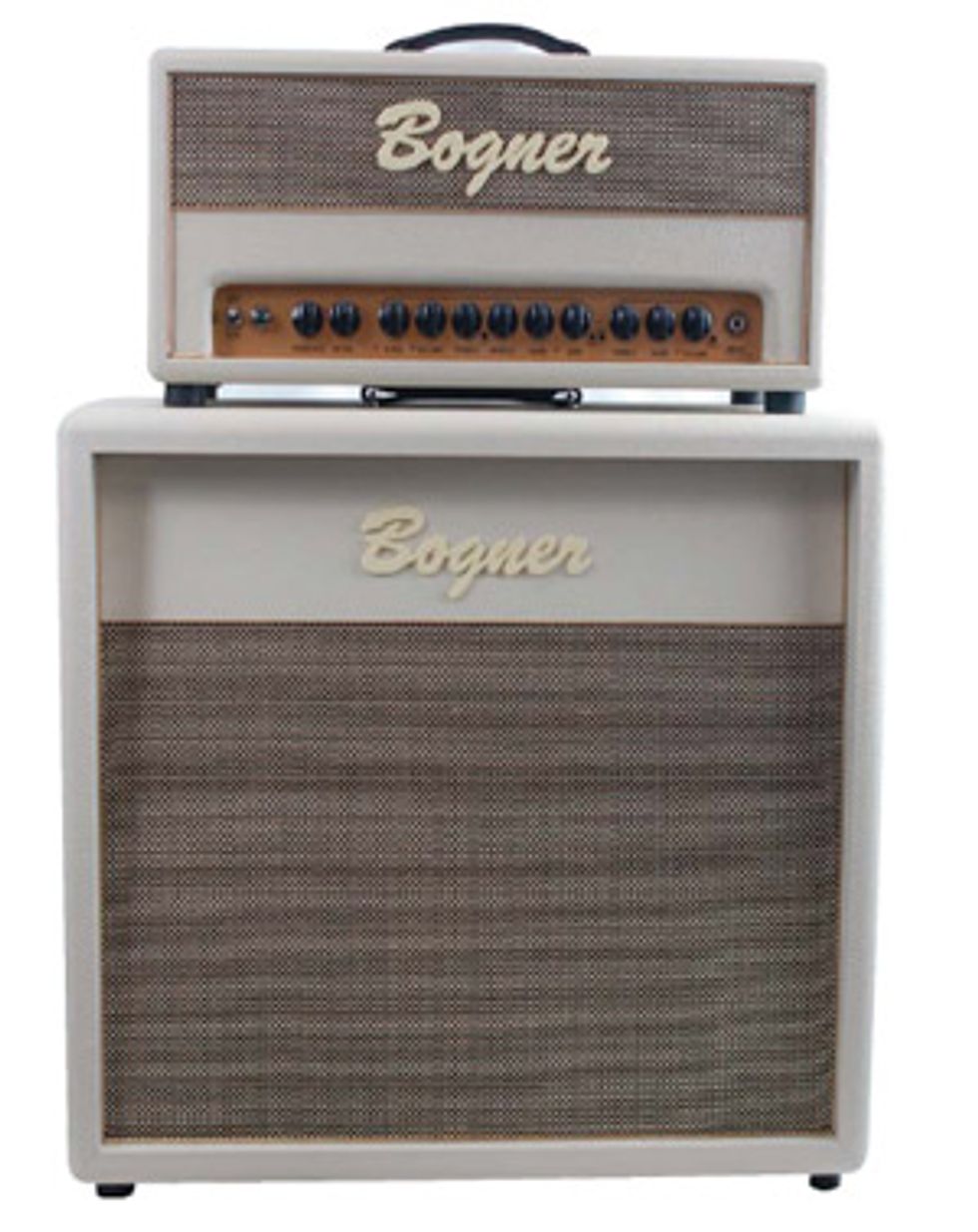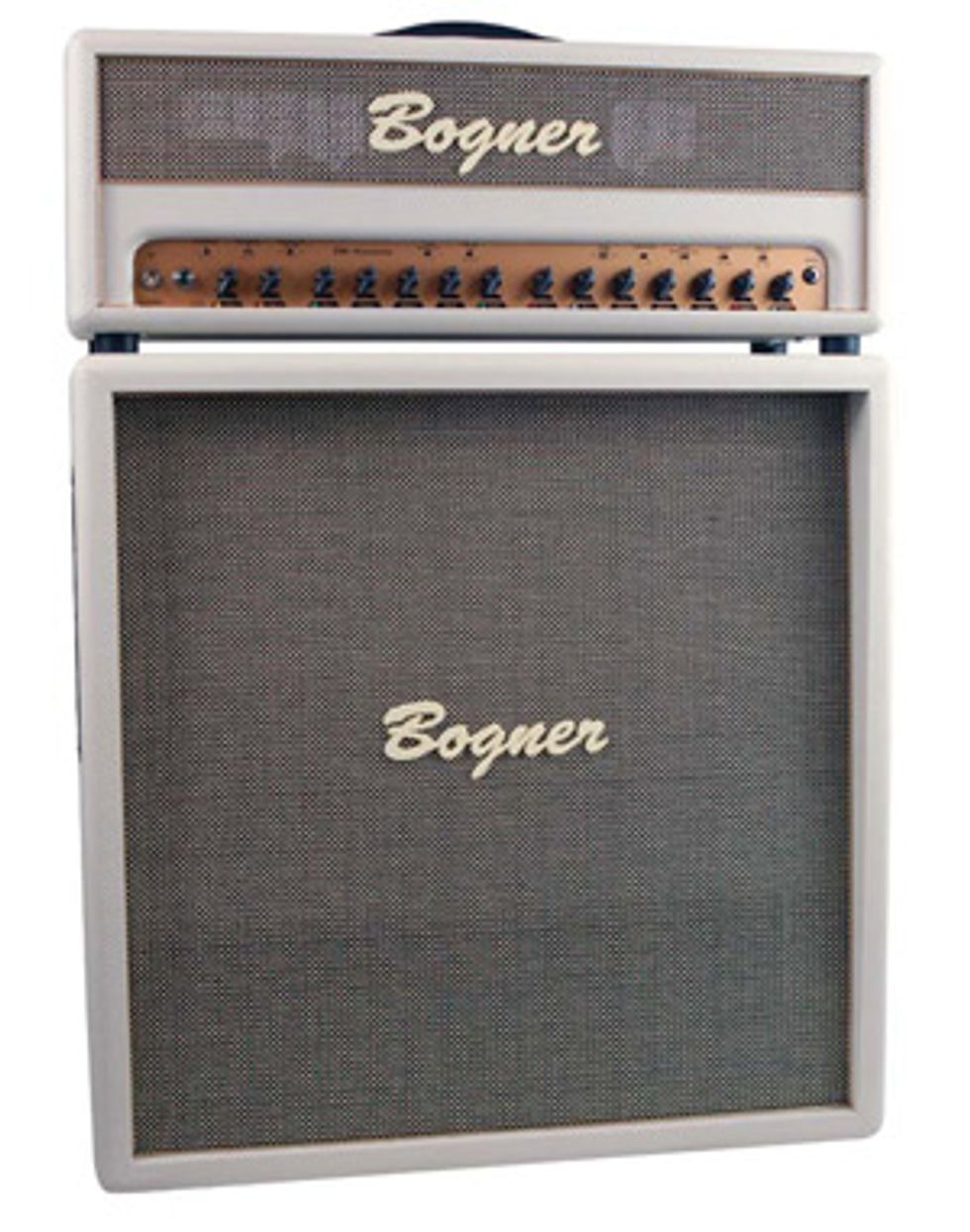From Steve Vai to Jerry Cantrell, scores of professional musicians and session players have used amplifiers produced by Reinhold Bogner. His expertise and know-how are legendary, and after only twenty years in the American amplifier business. To celebrate those illustrious two decades, Bogner has released the 20th Anniversary Series, based specifically on two of their most popular amps: the Shiva and Ecstasy. Finished in white tolex, plexiglass front panels and salt-and-pepper grille cloth, the new commemorative series is a beautiful sight to behold, with cabinets to match. A new visual style isn’t where it stops, however, since these amps have had some redesigns and re-voicing applied to their circuits, making them exclusive among the other amplifiers in the Bogner lineup. The Shiva has a redesigned boost circuit and different power tubes, and the Clean and Dirty preamps are completely new Designs. The Ecstasy has an almost entirely new preamp design with revitalized cleans and a voicing switch (dubbed Vintage/ Modern), among other additions. Not only do they sound a little different, but they feel a little different too.
 | |
| Download Example 1 Channel 1 | |
| Download Example 2 Channel 2 | |
The 20th Anniversary Shiva is a similar beast to its standard brethren, but has some extra trimmings that help differentiate it from the rest. First and foremost, it’s powered by a pair of mighty KT88 power tubes, which are known for their immense headroom and “wide” sound. The KT88 also exhibits more of a hi-fi effect compared to a more run-of-the-mill set of 6L6s or EL34s. They’re typically used in tube bass amps, but when used for guitar they have a very bouncy, dynamic feel with a large low-end response. The head utilizes a simple two-band EQ section (with bright switch) and a preamp Gain control for its clean tones, and a more familiar three-band EQ to alter and shape its gain tones. Working in tandem with those controls are two buttons labeled Shift and Mode, with the former shifting the EQ spectrum to have less mids, and the latter to add more aggression to the sound. Using a 2008 Fender American Stratocaster, I was able to get the classic Shiva clean tone with much more heft and definition.
Using the reverb control on the back helped deepen the sound. What was particularly impressive about the clean channel was how three-dimensional it was in this state. The amount of reverb (which has dedicated mix controls for each channel) available is immense, so I had to be careful not to wash the sound out. I found that for most applications, I never had to take the knob higher than 9 o’clock. The KT88s already provided a solid foundation—enough to shake the room— so the reverb was icing on the cake.
Also embedded in the new circuitry is a brand new boost circuit with a separate gain stage that’s exclusive to the clean channel. Bogner explains that when it’s engaged, it keeps the tone controls in an active state, unlike the boost circuit in the standard Shiva model, which bypasses the tone stack. When activated, the chimey, pristine, clean sound of the Shiva suddenly had enough gain available to take it into overdriven Super Lead territory, complete with a nice boost in the mids that kicked hard. The 2007 Gibson Flying V that I had plugged into it by this time seemed like the perfect match for this mode. This was an overdue reunion for me personally, since the clean channel of the Shiva was what initially impressed me with Bogner’s designs years ago. It was great to hear that full, cutting tone again and to be able to play around with some new attributes that made it sound even better than before.
Speaking of the gain channel, it’s received some upgrades of its own and been refined, so it has more gain available and two new switches to change its feel and aggressiveness. One of the things about the gain channel of the original Shiva that impressed me was how tight and thick it was when playing heavier chords—and how fluid and complex it could be when playing leads with the same tone settings. The 20th Anniversary model shares the same characteristics, but with a much less compressed result. When I was using it to jam with a band, the sound was very expansive, great for hard rock with a spongy midrange. While the Shiva’s overdrive certainly can sound mean and assertive, its natural organic nature prevents it from achieving thrashier, modern American-voiced metal tones, à la Exodus and Testament. Some players might view this as a blessing, as the Shiva’s overdrive channel high-end frequencies don’t exhibit the razor-sharp tendencies that those extreme genres command.
It could cut through with the right settings, but when used for rhythm it sat perfectly in the mix, hitting all the right frequencies to be heard and felt (and not drowned out by my pounding drummer). This was an issue with an older Marshall head that I had with KT88s in it—I just had to keep turning it up to be heard. Eventually, I was overpowering everyone else. Bogner got the voicing just right with this one, and it was fantastic. Finally, an Excursion knob on the back of the amp allows the player to adjust the bass response for their cabinet and get a less congested (but full) tone at lower volumes. The matching 2x12 cabinet (loaded with Celestion Vintage 30s) had amazing response and definition (absolutely stellar for a pair of twelve inch speakers), but even with its diminutive size, the amount of low end that it could project was too intense at times. When the bass got to be too much, I simply turned it down without losing any of the heft.
Buy if...
incredible cleans and a versatile, punchy overdrive is what’s needed.
Skip if...
you’re in need of a more modern metal tone.
Rating...
MSRP $3889 (Head + 2x12 Cabinet) - Bogner Custom Amplification - bogneramplification.com |
Hit page 2 for our review of the Ecstasy...
 | |
| Download Example 1 Channel 1 | |
| Download Example 2 Channel 2 | |
| Download Example 3 Channel 3 | |
With its reputation as one of the most versatile modern amplifiers ever made, it seems only fitting that Bogner’s flagship amp, the Ecstasy, would receive the 20th Anniversary treatment. It’s an intimidating-looking beast for sure, with a total of fourteen control knobs and ten micro switches on the faceplate alone. Reinhold has a reputation for constantly revising and improving his designs even after the product is released, and the Ecstasy has been one of his most laborious endeavors to date. For the 20th Anniversary model, he went with a brand new preamp circuit that differs from the Classic model that most Bogner players are familiar with.
I tested the head with its matching 4x12 cabinet, loaded with Celestion Vintage 30s, a 1978 Gibson Les Paul Custom with Tom Anderson pickups, and a 2008 Fender American Stratocaster. After letting the amp warm up and plugging in the Gibson, I noticed a feature on the footswitch that a lot of amp manufacturers should take note of: a standby switch. This is a fantastic idea, especially for recording musicians with their amps in isolation rooms. Being able to put the amp in standby from the footswitch seems like a minor feature, but it really is convenient—I’m surprised that it hasn’t been implemented in more amps.
The clean channel has a simple three-band EQ, and an assortment of tone-shaping switches. A three-position Pre-EQ switch—designed to react like a Bright switch on an old Twin—works in tandem with the Gain control. The lower the gain, the more effect the Pre-EQ setting will have. Eventually, I found a really great blues clean with the switch at B1, and the Gain just barely on the edge of breakup. On this setting the Ecstasy becomes very sensitive to pick attack, and digging in harder to the strings yielded a killer, harmonically rich blues lead. Activating the Gain Boost on the footswitch only made it fatter and more pleasing, which was perfect for long, sustaining runs.
For more high-gain applications, channels 2 and 3 really brought the goods. Both channels share a three-band EQ and have their own exclusive Gain and Volume controls. Each also has its own Pre-EQ control, like channel 1—but these treat the tone very differently, offering more than just added brightness. Bogner designed these switches to voice the channels, offering very perceptible changes to the tone when activated. One of my favorite tones coaxed from the second channel was with the Pre-EQ at B1, EQ settings slightly off from high noon, and the Gain set at 1 o’clock. Using the Strat and the best Eric Johnson-copping licks that I could muster, the Ecstasy pumped out one of the best low-gain rock tones that I’ve heard in a long time, complete with great sensitivity and extraordinary attack.
The 20th Anniversary Ecstasy also has assignable Presence controls that really do go a long way in helping you dial in the tone that you’re after. Before heading to the gain monster that was channel 3, I gave the Plexi Mode a spin. Players can assign this mode to either channel 2 or 3; it drastically lowers the preamp gain to allow the amp to imitate those great British amps from the ‘60s. It was pretty startling to hear just how well the Ecstasy did this in comparison to my ’67 and ’73 Marshall Super Bass heads. While those amps have more inherent low end, a lot of the same qualities were present in the Bogner: smooth upper mids, warm highs and, like most old Plexis, an even better sound when cranked to high heaven. I played with this one channel for hours before I even thought about the next one. It would make a great amp all on its own.
Forging ahead, I switched over to channel 3 and plugged in the Les Paul. This is the sound that made Bogner famous. Imagine the best qualities of British high-gain amplifiers melded into one, monstrous sound. Channel 3 has massive preamp gain on tap. It’s almost completely saturated by the time the gain control hits 10 o’clock. With many high-gain amplifiers, a higher setting would result in congestion and flabby definition; while the Ecstasy can be susceptible to this, careful dialing with the Master Volume and a lower preamp gain setting can control it.
Just like the Shiva, the Ecstasy has Pre-EQ switches for each of its three channels. With the switch set at N (normal brightness) and the tone controls set so that the treble and bass were boosted slightly, a great high-gain rock tone materialized almost effortlessly. With the assignable Presence control added on, the amp achieved an amazing, tight hard rock sound, a’la Jerry Cantrell and Adam Jones. Channel 3 was without doubt capable of delivering some of the best heavy rock tones that I’ve ever heard. But even with its massive power and gain, this high-gain monster doesn’t hide any mistakes. The Ecstasy is a player’s amp, and has no time for sloppiness.
The front panel features of the Ecstasy are only half of the equation. Starting off on the far left side of the rear panel, the head includes an effects loop (switchable between series and parallel) with its own Mix and Master Volume controls. Using these together allows the player maximum control over the loop mix, preventing any unwanted clipping. The panel also houses three channel select buttons (in case you want to leave the footswitch at home) and a line out jack with level control. To the right of that is a more curious option, a switch labeled “Old/New.” This is a selector to switch between Pentode and Triode modes. When the amp is in “New” (pentode) mode, all four power tubes are working on full power; when it’s in “Old” (triode) mode, only three out of five elements in each tube are running. Its effect is to smooths out the frequencies, and it reminds me of a cathodebiased amp in terms of sound and playability. The downside is that reduces power output, so it limits headroom—watch your Volume and Gain controls when the head is in this state.
Finally, the Ecstasy also sports a half-power option with a switch that takes two of the power tubes out of the circuit and knocks it down to 60 watts. For anybody who’s ever run their 100-watt head with only two tubes and enjoyed the tone, this is for you—though you will have to change the impedance setting in this mode. Combined with the Old/New switch, this option lets the player tame the head to a respectable volume.
Buy if...
you love British-voiced tone, and you’re after an amp that can do it all with its own flavor.
Skip if...
you need a simpler rig. While the Ecstasy covers a lot of ground quite well, some might be more comfortable with a simple combo and a pedal.
Rating...
MSRP $4425 (Head); $1199 (4x12 cabinet) - Bogner Custom Amplification - bogneramplification.com |
The Final Mojo
Both the 20th Anniversary Shiva and Ecstasy amplifiers are visually and aurally stunning— fitting tributes to the two decades of incredible guitar tones that Reinhold Bogner has given the music world. The Shiva’s smooth and commanding gain channel coupled with one of the best clean channels in the business makes it a simple, highly usable and unique amplifier for gigging and recording. The reverb sounds phenomenal, and the Excursion knob is a great tool for tuning the amp to the cabinet of your choice. For those players who desire more options at their fingertips, the Ecstasy, with its three separate channels and myriad of usable customization choices, is an incredible choice with very few alternatives in its league. Each channel has its own character and feels like a separate amplifier altogether, and the assignable Presence controls are very effective in helping the player zero in on the tone in their head.
Each amp comes with an optional matching cabinet, 2x12” or 4x12”, finished in the same white tolex and salt-and-pepper grille cloth that adorns the heads. The circuitry and materials are essentially the same as the standard offerings, both are loaded with Celestion Vintage 30s, and both sound very impressive. I think ultimately that’s what impresses me the most about the both of these amps; while most pieces of gear with a lot of tonal options can intimidate a player, these just make me want to play even more. These are tools that will inspire players to create.








![Rig Rundown: Russian Circles’ Mike Sullivan [2025]](https://www.premierguitar.com/media-library/youtube.jpg?id=62303631&width=1245&height=700&quality=70&coordinates=0%2C0%2C0%2C0)

















